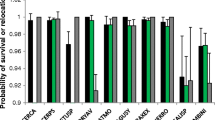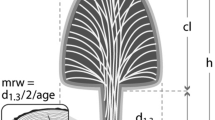Abstract
We present a technique for estimating size-age relations and size-dependent mortality patterns of long-lived plants. The technique requires two sets of size data of individual (non-marked) plants that should be collected with a time-lag of several years in the same area of a study site. The basic idea of our technique is to assume general (three parameter) families of size-dependent functions which describe growth and mortality that occurred between the two data gathering events. We apply these growth and mortality functions to the size data of the early data set and construct predicted size-class distributions to compare it, in a systematic way, to the size-class distribution of the later data set. In a next step we calculate the size-age relations from the resulting growth functions, which yield the smallest difference between observed and predicted size-class distribution. Applying this technique to size data of five dominant shrub species at the Tierberg study site in the semiarid Karoo, South Africa produced new insight into the biology of these species which otherwise cannot be obtained without frequent measurements of marked plants. We could relate characteristics of growth behavior and mortality, for certain subgroups of the five species, to the life-history attributes evergreen vs. deciduous, succulent vs. woody, and early reproductive vs. late reproductive. The results of our pilot-study suggest a broad applicability of our technique to other shrublands of the world. This requires at least one older record of (individual) shrub-size data and performance of resampling.
Similar content being viewed by others
References
Archer, S., Scifres, C. & Bassham, C. R. 1988. Autogenic succession in a subtropical savanna: conversion of grasslands to thorn woodland. Ecol. Monog. 58: 111–127.
Arnold, T. H. and B. C. de Wet (eds) 1993. Plants of Southern Africa. Mem. Bot. Surv. S. Afr. 62: 1–825.
Ash, A. J. & McIvor, J. G. 1998. How season of grazing and herbivore selectivity influence monsoon tall-grass communities of northern Australia. J. Veg. Sci. 9: 123–132.
Batista, W. B., Platt, W. J. & Macchiavelli, R. E. 1998. Demography of a shade-tolerant tree (Fagus grandifolia) in a hurricane-disturbed forest. Ecology 79: 38–53.
Begon, M., Harper, J. L. & Townsend, C. R. 1990. Ecology -Individuals, populations and communities. Blackwell Scientific Publications, Boston, USA (see chapter 14).
Chambers, J. C. & Norton, B. E. 1993. Effects of grazing and drought on population dynamics of salt desert shrub species on the Desert Experimental Range, Utah. J. Arid Environ. 24: 261–275.
Cowling, R. M. & Hilton-Taylor, C. 1999. Plant biogeography, endemism and diversity. In: Dean, W. R. J. and Milton, S. J. (eds), The Karoo: ecological patterns and processes. Cambridge University Press, Cambridge.
Dunwiddie, P.W. & la Marche, C. V. C. 1980. A climatically responsive tree ring record from Widdringtonia cedarbergensis, Cape Province, South Africa. Nature 286: 796–797.
Esler, K. J. 1993. Vegetation patterns and plant reproductive processes. Dissertation, University of Cape Town, Cape, South Africa.
Fourie, J. H., de Wet, N. J. & Page, J. J. 1987. Veldtoestand en neiging in Kalahari duineveld onder 'n ekstensiewe veeboerderystelsel. J. the Grassland Soc. Southern Afr. 4: 48–54.
Friedel, M. H., Pickup, G. & Nelson, D. J. 1993. The interpretation of vegetation change in a spatially and temporally diverse arid Australian landscape. J. Arid Environ. 24: 241–260.
France, J., Thornley, J. 1984. Mathematical Models in Agriculture. Butterworths, London.
Gourlay, I. D. 1995. Growth ring characteristics of some African Acacia species. J. Tropical Ecol. 11: 121–140.
Hoffman, M. T. & Cowling, R. M. 1990. Vegetation change in the semi-arid eastern Karoo over the last 200 years: an expanding Karoo -fact or fiction? South Afr. J. Sci. 86: 286–294.
Kellerman, T. S., Coetzer, J. A. W. & Naude, T. W. 1988. Plant poisonings and mycotoxicoses in livestock in southern Africa. Oxford University Press, Cape Town.
Lange, R. T. & Sparrow, A.D. 1992. Growth rates of western myall (Acacia papyrocarpa Benth.) during its main phase of canopy spreading. Austr. J. Ecol. 17: 315–320.
Loehle, C. 1988. Tree life history strategies: the role of defenses. Can. J. Forestry Res. 18: 209–222.
McAuliffe, J. R. 1988. Markovian dynamics of simple and complex desert plant communities. Am. Nat. 131: 459–490.
Milton, S. J. 1993. Insects from the shrubs Osteospermum sinuatum and Pteronia pallens (Asteraceae) in the southern Karoo. Afr. Entomol. 1: 257–261.
Milton, S. J. 1994. Growth, flowering and recruitment of shrubs in grazed and in protected rangeland in the arid Karoo, South Africa. Vegetatio 111: 17–27.
Milton, S. J. 1995. Spatial and temporal patterns in the emergence and survival of seedlings in arid Karoo shrubland. J. Appl. Ecol. 32: 145–156.
Milton, S. J., Dean, W. R. J. & Kerley, G. I. H. 1992. Tierberg Karoo Research Centre: history, physical environment, flora and fauna. Trans. Royal Soc. S. Afr. 48: 15–46.
Milton, S. J., Gourlay, I. D. & Dean, W. R. J. 1997. Shrub growth and demography in arid Karoo, South Africa: inference from wood rings. J. Arid Environ. 37: 487–496.
Noy-Meir, I. 1990. Responses of two semi-arid rangeland communities to protection from grazing. Israel J. Bot. 39: 431–442.
O'Connor, T. G. 1995. Transformation of a savanna grassland by drought and grazing. Afr. J. Range Forage Sci. 12: 53–60.
O'Connor, T. G. and Roux, P. W. 1995. Vegetation changes (1949-71) in a semi-arid, grassy dwarf shrubland in the Karoo, South Africa, influence of rainfall and grazing by sheep. J. Appl. Ecol. 32: 612–626.
Rosati, V. R. & Bucher, E. H. 1995. Relative abundance and diet composition of Chacoan cavies in relation to range condition. J. Range Manag. 48: 482–486.
Shreve, F. & Hinckley, A. L. 1937. Thirty years of change in desert vegetation. Ecology 18: 463–478.
Tilman, D. 1994. Competition and biodiversity in spatially structures habitats. Ecology 75: 2–16.
Turner, R. M. 1990. Long-term vegetation change at a fully protected Sonoran Desert site. Ecology 71: 464–477.
Van der Heyden, F. 1992. Effects of defoliation on regrowth and carbon budgets of three semi-arid Karoo shrubs. PhD thesis, University of Cape Town.
Vasek, F. C. 1980. Creosote bush: long-lived clones in the Mojave Desert. Am. J. Bot., 67: 246–255.
Whisenant, S. G. & Wagstaff, F. J. 1991. Successional trajectories of a grazed salt desert shrubland. Vegetatio 94: 133–140.
Wiegand, T., Milton, S. J. & Wissel, C. 1995. A simulation model for a shrub ecosystem in the semiarid Karoo, South Africa. Ecology 76: 2205–2221.
Author information
Authors and Affiliations
Rights and permissions
About this article
Cite this article
Wiegand, T., Milton, S.J., Esler, K.J. et al. Live fast, die young: estimating size-age relations and mortality pattern of shrubs species in the semi-arid Karoo, South Africa. Plant Ecology 150, 115–131 (2000). https://doi.org/10.1023/A:1026526419886
Issue Date:
DOI: https://doi.org/10.1023/A:1026526419886




